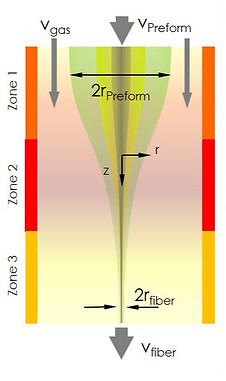
Applications
Piezoelectric polymers demonstrate excellent performance as highly sensitive sensors. While traditional sensors used a “point sensing” method that measured at a single point, InteractOn enables “distributed sensing” across a wide area by manufacturing piezoelectric fibers and using smart textiles or embedded sensor arrays. This provides a much richer and more contextualized dataset, going beyond simply detecting “deformation” to identifying “where the deformation is” and analyzing “whether the deformation pattern resembles a crack.” Furthermore, the combination of flexibility and biocompatibility for skin adhesion is ideal for non-invasive health monitoring. Therefore, these sensors are well suited for detecting minute mechanical deformations from physical activity.

Piezoelectric Fiber Sensors
InteractOn offers piezoelectric fiber sensors with a proprietary coaxial fiber format. The unique Thermal Drawing platform enables continuous production of fiber sensors. Our fibers combine high-performance & sensitive materials (piezoelectric polymers & AgNWs) to enable highly sensitive motion tracking.
-
Key Properties:
-
Long & Flexible fiber-shaped sensor
-
Possibility of embedding in various textiles or sensor arrays
-
Excellent thermal and chemical stability
-
Proven reliability for sensor applications
-
Application Fields
-
Smart Textiles:
The most representative and promising application for piezoelectric fibers is the creation of "wearable electronics." By weaving piezoelectric fibers into a chest band or shirt, it's possible to monitor respiration rate and heart rate in real-time by detecting the expansion of the chest during breathing and the subtle vibrations from a heartbeat. This enables continuous health management in daily life without relying on hospital equipment. In addition, Piezoelectric fibers integrated into sportswear can precisely measure the degree of contraction and relaxation of specific muscles, movement balance, and fatigue levels. This allows athletes to correct their posture and maximize training efficiency, and enables objective data tracking of a rehabilitation patient's recovery process.
-
Human-Machine Interface (HMI):
Piezoelectric fibers can be used to create intuitive interfaces that translate human movements or intentions into signals that machines can understand. Clothing made with piezoelectric fibers can precisely detect human motions. This enables applications such as complex manipulations in virtual reality (VR) environments, remote control of robotic arms, and translation of sign language into voice or text.
-
Safety and Protective Gear:
Piezoelectric fibers excel at detecting impacts and abnormal movements, enabling the creation of intelligent protective equipment that safeguards individuals in various hazardous situations. By embedding piezoelectric fibers into helmets and knee pads for athletes or industrial workers, it is possible to record and analyze the intensity, location, and frequency of external impacts in real-time. For example, the impact force on a soccer player's head during a header can be quantified to warn of and manage the potential risk of injuries like concussions.
-
Human Motion Tracking & Medical Diagnostics:
Piezoelectric fibers provide an innovative tool for the quantitative analysis of human movement in fields such as physical therapy, sports science, and the diagnosis of neuromuscular disorders. This helps clinicians and therapists evaluate a patient's condition based on objective data and formulate personalized treatment plans. An ultra-compliant patch sensor made from P(VDF-TrFE) fibers can be attached to the skin over a specific muscle to detect minute changes in its shape during contraction and relaxation. This allows for the differentiation of various muscle contraction types (e.g., isometric, concentric, eccentric) and even the monitoring of fatigue-induced tremors during exercise. This technology provides essential data for tracking recovery after a muscle injury or assisting in the diagnosis of conditions such as Parkinson's disease or muscular dystrophy. In addition, By integrating piezoelectric fibers into socks, insoles, or full-leg garments, the spatiotemporal parameters of a person's gait (e.g., stride length, speed, balance) can be precisely measured. This can be utilized in rehabilitation training to improve the walking patterns of stroke patients or by athletes to correct their running form, thereby preventing injuries and enhancing performance.